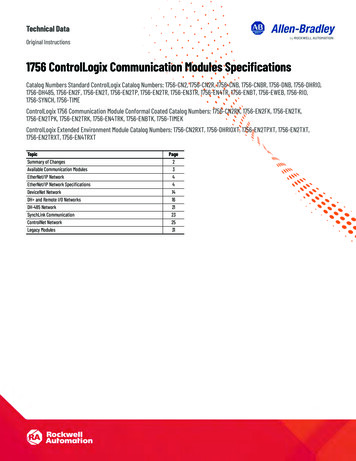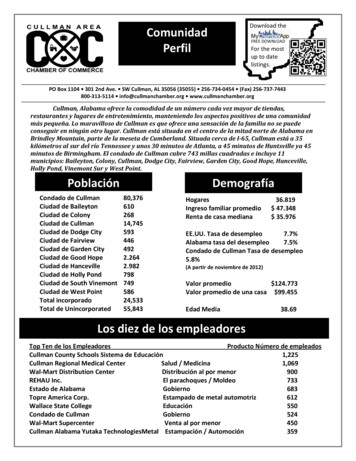
Transcription
DOCUMENT RESUMEED 256 442AUTHORTITLEINSTITUTIONPUB DATENOTEPUB TYPEEDRS PRICEDESCRIPTORSJC 850 219Weintraub, Jeffrey I.A Follow-Up Study of LaGuardia Community College's1973-1979 Graduates.La Guardia Community Coll., Long Island City, N.Y.[84]19p.Reports - Research/Technical (143) -- StatisticalData (110)MF01/PC01 Plus Postage.*College Graduates; *College Transfer Students;Community Colleges; Cooperative Education; EducationWork Relationship; *Employment Patterns; LongitudinalStudies; Outcomes of Education; Two Year Colleges;Two Year College Students; Vocational Education;Vocational FollowupABSTRACTIn 1983-84, a follow-up study was conducted ofstudents who graduated from LaGuardia Community College (LCC) between1973 and 1979 to provide information on the number of studentsentering the labor market; the types of positions they received; theindustries in which they found employment; and their startingsalaries. Questionnaires were sent to 2,327 graduates, who weredeemed reachable on the basis of two earlier studies, and responseswere received from 670 (28.8%). Study findings revealed: (1) theaverage salary for 1973 graduates was 20,250, while 1979 graduatesearned an average of 15,769; (2) data processing graduates had thehighest starting salary ( 10,639) and the highest percentage increasein salary over the period (1090; (3) occupational therapy graduatesreported the lowest increase in salary (55%); (4) 63% of thegraduates continued their education after graduation from LCC, and56% of these had attained a bachelor's degree or better by mid-1983;(5) rates of transfer were highest among human services graduates(82%) and liberal arts graduates (78%), and lowest among dataprocessing (39%) and secretarial science (37%) graduates; and (6) 50%of the employed graduates had remained with their first ************************************Reproductions supplied by EDRS are the best that can be made**from the original *****************************
U& DEPANTIIIIIT OF EDUCATION"PERMISSION TO REPRODUCE THISMATERIAL HAS BEEN GRANTED BYNATIONAL INEITITUTE OF EDUCATIONEDUCATIONAL RESOURCES INFORMATIONCENTER IERC IJ. Weintraub(I The document hoe been reproduced asrammed from the person or orpenuotionoroneting n(%JrMinor changes have been made to improvereproduction aveirty.4)Points of wee or opinions Wald In dire doa mem do not necsserey represent official NMTO THE EDMATIONAL RESOURCESINFORW7ION CENTER IERIC,motion or policy.A FOLLOW-UP STUDY OF LaGUARDIA COMMUNITY COLLEGE'S 1973-1979 GRADUATESPrepared byProfessor Jeffrey WeintraubDirector of Placement2
A FOLLOW-UP STUDY OF LaGUARDIA COMMUNITY COLLEGE'S 1973-1979 GRADUATESAs an educational institution that is totally committed to career /cooperative education(CCE), it is appropriate that the college look at the performance of its graduates inthe labor market as a key measure of its educational effectiveness. in its catalog,LaGuardia Community College states that a primary mission of the college is:quality career programs for students who plan to enter the labormarket on a technical or para-professional level after graduation;transfer programs for students who plan to complete baccalaureateprograms at a four-year college or university.This mission is in tune with the primary reason that has been consistently cited byentering freshman for going to college: improvement of their economic status.Each year since 1973, when LaGuardia Community College graduated its first class,the college has sought to conduct a follow-up study of the graduates approximatelythree to six months after graduation. The purpose of these studies was to obtaininformation on the number of students entering the labor market with an AssociateDegree, the types of positions received, industries in which they found employmentand their starting salaries. Consequently, the data showed that LaGuardia studentsfared well in the labor market with high percentage of graduates who soughtemployment finding a job in their area of interest. The vast majority tended to beemployed by a cooperative education employer and, on the average, they appearedto receive a higher starting salary than was reported by the Middle Atlantic CareerCounseling Association (MACCA) for two-year college graduates within the region.Although the college's graduates do well in the beginning, it can be argued thatsuccessful implementation of its CCE philosophy should result in graduates notonly sustaining their original advantage in the labor market, but showing growthand advancement as reflected by salary advances and promotional advancement.Otherwise, it could be concluded that the initial advantage of LaGuardia graduatesin the labor market may reflect nothing more than the 9 months work experienceobtained through the Cooperative Education Program. In order to look at thisissue the college has conducted three longitudinal follow-up studies of its graduates.The first in 1978 which analyzed 1973-75 graduates, the second in 1980 analyzing1973-1977 graduates and this current study conducted in 1983-84.The three studies coupled with the yearly "Graduate Placement Report" providea comprehensive indepth view of LaGuardia graduates'performance both in thelabor market and at subsequent institution institutions of higher learning.
REPORT HIGHLIGHTS1973 Graduates are earning an average salary of 20, 250 with a range of 14,144 40,000.(p. 3)1974 Graduates are earning an average salary of 20,427 with a range of 10,400 45,000,(p. 3)-- 1975 Graduates are earning an average salary of 19,162 with a range of 10,000 - 40,500.(p. 3)-- 1976 Graduates are earning an average salary of 17,845 with a range of 9,000 38,000.(p. 3)- - 1977 Graduates are earning an average salary of 18,051 with a range of 7,176 - 40,000. (p. 3)- - 1978 Graduates are earning an average salary of 17,470 with a range of 9,100 - 30,000. (p. 3)1979 Graduates are earning an average salary of 15,769 with a range of 9,000 30,000.(p. 3)Data Processing and Accounting graduates report the highest salary gains.(p. 4)Occupational Therapy graduates report the lowest salary gains.(p. 4)In some curricular areas there is a positive correlation between post LaGuardiaeducation and current salary. (pp. 5-6)The positive correlation between post LaGuardia education and current salaryincreases over time spent in the labor market. (pp.6-7)63% of the 1973-1979 graduates continued their education after graduation.(p. 8)Of those graduates who continued their education 56% have attained a BachelorsDegree or better as of 6/83. (p.Human Services graduates 82% and Liberal Arts graduates 78% transfer tosenior institutions at the highest rate. (p.9)Data Processing graduate:, 39% and Secretarial Science graduates 37% transferat the lowest rate. (p. 9)More LaGuardia graduates transfer(1:11.Baruch than any other C.U.N.Y. college.10)38% of LaGuardia's graduates transfer outside C.U.N.Y. (p.15)-- Of those graduates earning a Bachelors Degree 33% obtain it within two yearsafter graduating LaGuardia, 59% within three years. (p. 11)Graduates who obtain an advanced degree take from 3-9 years after graduatingfrom LaGuardia to do so. (p. 12).50% of the employed graduates have remained with VI( it first employer.(pp. 13-14)4
A FOLLOW-UP STUDY OF LaGUARDIA COMMUNITY COLLEGE'S19731979 GRADUATESThis follow-up study, the third longitudinal analysis of LaGuardia graduateswill continue to provide analysis of how LaGuardia graduates perform as postcommunity college graduates. While specifics such as salary, additional education,job stability and job complexity will be reviewed in depth, one will also be ableto derive certain non-specific or global outcomes of LaGuardia graduates from thedata presented. The outcomes presented are for all LaGuardia graduates irrespectiveof day or evening attendance, full or part-time undergraduate status, or whetherthe graduates participated in LaGuardia's Cooperative Education Program. LaGuardia'sundergraduate student population represents a true cross section of the traditionalcollege population. While the majority of LaGuardia students come directly fromhi3h school, others are gainfully employed and come to the college to hone theirskills or gain the educational requirements needed for advancement, and a thirdsegment while employed are looking for a career change and see LaGuardia as aprimary vehicle. LaGuardia Community College attempts to meet the educationalneeds of these primary groups by providing them with comprehensive courses ofstudy, a cooperative education program and a variety of support services designedto help students make the adjustment to the responsibilities of college.DATA COLLECTION:LaGuardia Community College graduated 4514 students in the period encompassing1973- 1979. Based upon the data collected from the prior longitudinal studies 1,2and other mailings to graduates, certain graduates were deemed unreachable,as earlier attempts to reach these graduates resulted in the letters being returnedby the postal service. Each graduate deemed reachable was sent a questionnaire,a second questionnaire was mailed after three weeks if there was no response.641 graduates responded to the mail questionnaire and an additional 29 graduateswere contacted randomly by telephone yielding a total response of 670 graduates.These 670 graduates represent 15% of the graduate population, -"th an effectiveresponse rate* of 28.8%.TABLE IRESPONSE BY YEAR OF GRADUATION :YEAR OF# OFREACHABLE RESPONDING EFFECTIVE %OF ALL GRADS11 11R5NSE* RESPO-MhttGRMIThiribN GRADUATES CRAIUATES e response rate is the percentage of graduates who responded to thequestionnaire as a total of all graduates who received a questionnaire. i.e. totalquestionnaires received/questionnaires sent minus undeliverable.l Professor Jeffrey Weintraub - A preliminary Analysis of LaGuardia CommunityCollege's 1973-1975 Graduates. November 19782. Professor Jeffrey Weintraub - A follow-up Study of LaGuardia Community College's197-1977 Graduates. November 1981-1-
SAMPLE REPRESENTATIVENESS:In examining the response rate by the year of graduation there is an overrepresentation of the Class of 1979 and conversely an underrepresentationof the Classes of 1973 and 1974. this Is due to the difficulty of keepingin touch with the 1973 and 1974 graduates who may have moved numeroustimes in the 8-9 years since graduation.TABLE II - GRADUATION YEAR SAMPLING:# GRADS1973197419751976197719781979TOTAL# RESPONDING 17.3%4470100. 293116104The response rate by LaGuardia curriculum (major) indicates a slight overrepresentation of Secretarial graduates and similar underrepresentation ofBusiness graduates. Thes13 variances are similar to those cited in previouslongitudinal studies and will have a negligible effect in the statistical analysis.TABLE III - LaGUARDIA CURRICULUM SAMPLING :# GRADSAccountingBusiness AdministrationData ProcessingLiberal ArtsSecretarial Science1;1. Assoc.aman ServicesOccupational %15.7%8.2%10.6%3.4%---UnknownTOTAL# RESPONSES%100. %4470-2-6589759%8.7%VARIANCE16012857782923 )%2.0%3.1% .1%1.2%L.1% 3.4%4.6%670100. %14.5%8.8%8.5%11.6%4.3% .3% 1.0% .9% .6%0
SALARY:The following series of tables will examine the salaries of LaGuardia graduatesfrom date of graduation thru April 1983. While sa;ry alone in many instancesIs construed as a level
Data Processing graduate:, 39% and Secretarial Science graduates 37% transfer. at the lowest rate. (p. 9) More LaGuardia graduates transfer. Baruch than any other C.U.N.Y. college. (1:11. 10) 38% of LaGuardia's graduates transfer outside C.U.N.Y. (p.15)-- Of those graduates earning a Bachelors Degree 33% obtain it within two years











